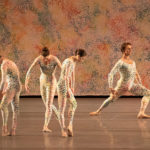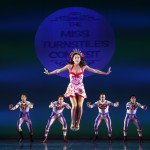New York City Ballet’s Swan Lake is a fixer-upper with great bones: mesmerizing lakeside scenes populated by caffeinated swan-maidens, vividly ironic national dances, and an epic denouement. The fixes are low-hanging fruit – why the company hasn’t gotten around to them is a mystery.
The costs of sets and costumes have surely been fully amortized since Peter Martins debuted this production in the last century. Let’s not mess with the lakeside backdrops by Danish painter and arctic geologist Per Kirkeby, whose wintry prospects and gnarled thickets brilliantly foreshadow the tragic end. But Kirkeby must have been an anti-monarchist – why else would he paint the palace walls a hideous mustard, allot Prince Siegfried a stingy wooden throne best suited to a kindergarten ‘time out’ corner, dress the prince’s birthday party guests in color-clashing garments evocative of gamekeepers rather than the aristocracy, and sling outsized Elizabethan ruffs that resemble all-terrain-vehicle tires around the necks of the Queen and her courtiers?
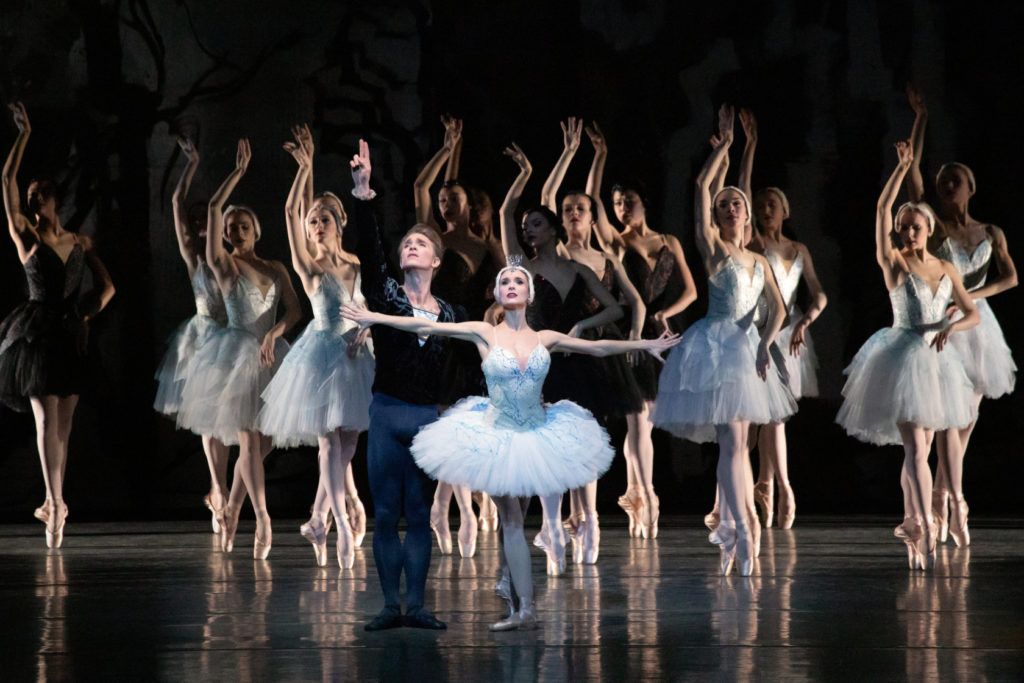
Design snafus aside, the court scenes are dominated by the most tiresome jester in the history of royal families. In Act II he comes with three mini-me’s. His shtick consists of spinning and cabrioles, punctuated by bouts of narcolepsy. In performance on February 21st, Sebastian Villarini-Velez delivered the gymnastics with little musicality. When not busy avoiding the jester, birthday party guests had to avoid kicking each other as they dashed in and out of formations at breakneck speed. I was disappointed to see that the exhilarating and fiendishly tricky pas de quatre, one of the divertissements from Act II, had been eliminated this season – if only it had been substituted for the humdrum ballroom revels in Act I.
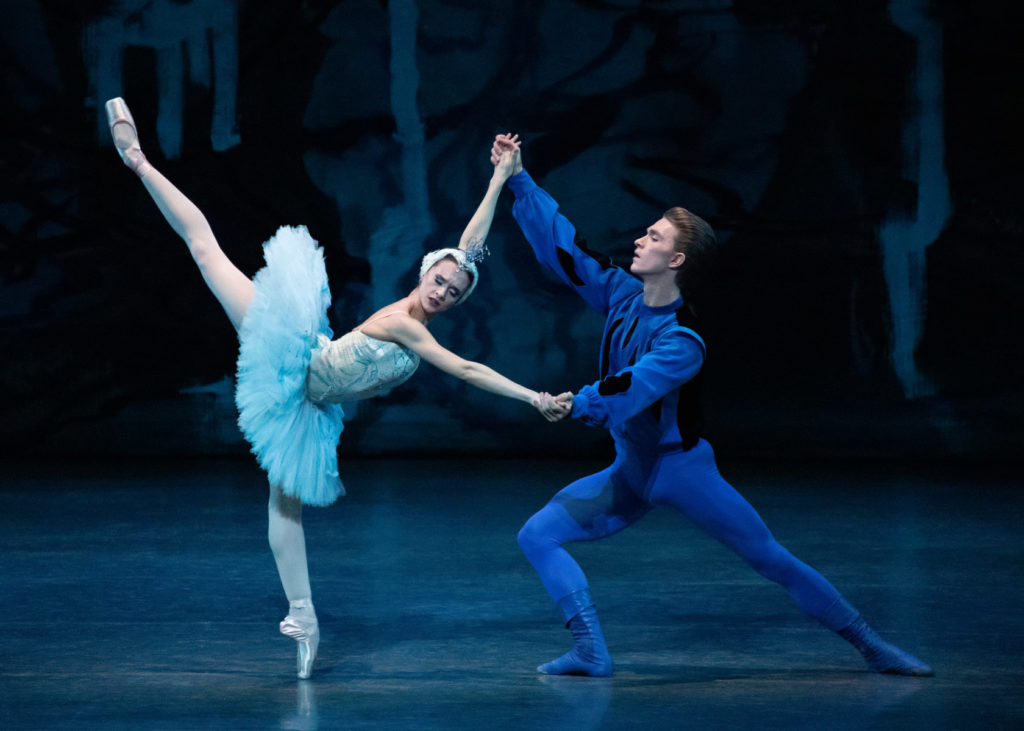
Martins borrowed liberally from the Petipa/Ivanov warhorse and George Balanchine’s one-acter. Perhaps he should have borrowed more. If the idea of Martins returning to the studio to further tinker with his work is awkward for the company that not long ago declared him persona non grata, why not pass the torch to a younger choreographer and continue the time-honored tradition of messing with the grand old story ballets?
Let’s hope they leave intact the Act II Spanish, Hungarian and Russian dances. No doubt meant to celebrate imperial dominion, these dances in many productions are rife with ethnic clichés. But here, inside the austere prison of a backdrop that was meant to represent a palace ballroom, Kirkeby’s odd costumes scrambled clichés, and Martins’ witty choreography appeared to poke fun at nationalist sentiment. In the Spanish, Lars Nelson grinned nuttily and Gilbert Bolden III smoldered, in their velvet breeches and neon pink stockings, while the dynamite Laine Habony and Mary Elizabeth Sell twitched their shoulders and narrowed their eyes. In the Hungarian, the proud Gretchen Smith seemed to nurse a secret sorrow, while Sean Suozzi, his deep-set eyes weary, prepared once more to lead his nation in to battle. Emilie Gerrity and Silas Farley were a superb match in the sultry Russian dance, their long, powerful limbs intertwining in risky configurations.
And let’s not mess with the role of Odette-Odile, to which City Ballet’s ballerinas have brought their idiosyncratic gifts. In recent seasons I witnessed the captivating debuts of Tiler Peck and Megan Fairchild (reviewed for Dance Europe) and the repeated triumphs of Sterling Hyltin, Sara Mearns and Ashley Bouder.
This season, Lauren Lovette and Harrison Ball stepped up to bat for the first time. Other City Ballet Siegfrieds have managed to make the most of the scant airtime allotted by Martins but Ball made the faintest of impressions on February 21st. The emotions visible on his face ran the gamut from boredom to petulance and angst but were largely unreflected in his clean, unmodulated technique. It didn’t help that his solo variation in Act I was barely visible in the overly moody lighting that camouflaged the Prince, clad in blue against an indigo backdrop.
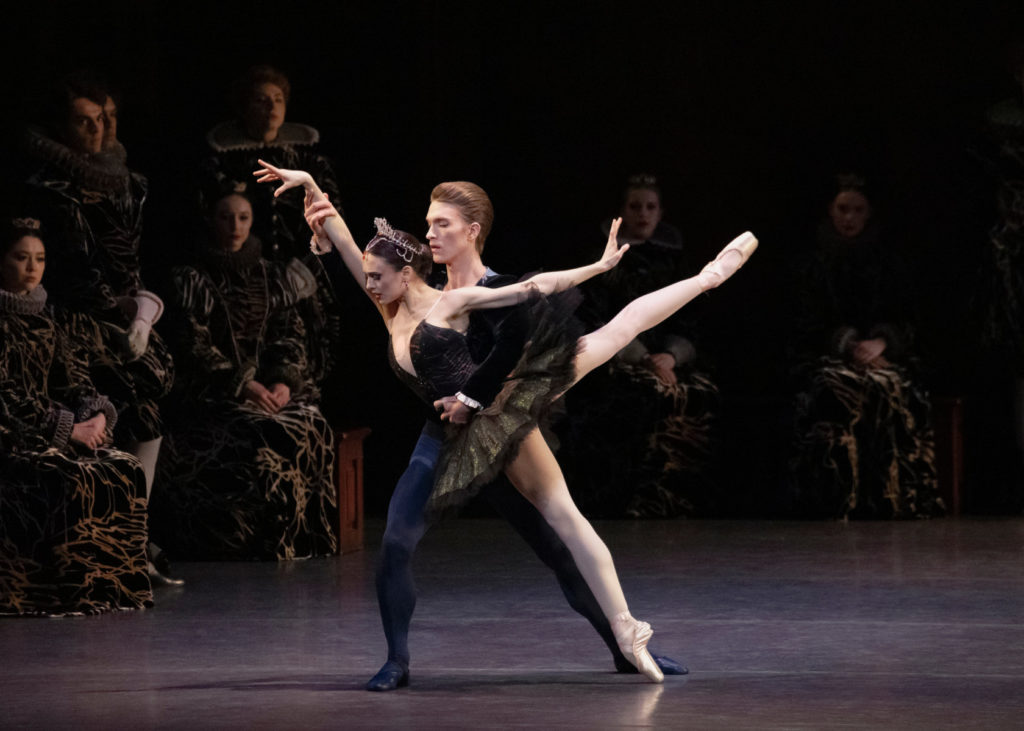
Known for her airiness and speed, Lovette brought a profound gravity and groundedness to her Odette. She embellished her fearless piqués into attitude with an expansive arch of her back, and tackled her Act I solo with a restive glamour. One sensed an extraordinary bond between her and the swan corps – she was not so much their queen as their democratically elected representative.
There is a wild streak to these swans: they tear around with slightly less refinement and military precision than you find in the more classically oriented companies; they deploy their ‘wings’ with greater impetuousness; and they stand up to the crossbow-wielding hunters with audacity. It is into their stalwart ranks that Odette returns in the heart-rending but dramatically satisfying conclusion.
While the tempi in this Swan Lake generally race along at a Balanchinean clip, the pace of the Act I adage was dialed down to funereal, which took some of the zing out of this strange, exquisite encounter between man and fantastical creature.
The adrenaline ramped back up in Act II when Lovette burst on as the temptress Odile, hard as nails. Poor Siegfried didn’t have a prayer (even though the rest of us found her conspiratorial huddling with the seedy-looking Von Rotbart highly suspicious.) It was thrilling to watch her go for broke, and though she careened out of her fouettés into a less than secure round of piqué turns, there was no time to rue the mishap – for she had a Prince to destroy, then a mad dash backstage to rip off the black tutu and re-emerge as the heartbroken Odette.
The scene in which she forgave the stricken Siegfried was intimate and affecting. They then hustled downstage as if to escape before the evil Von Rotbart showed up. At that moment, Lovette gazed into Ball’s eyes and smiled broadly – which I thought disconcerting. I can’t recall another Odette displaying such confidence under the circumstances.
Moments of illogic were vanquished by the intrepid battalion of swans, as they wafted on and off stage in their dissolving and crystallizing architectures. Most glorious of all, the final imagery of Odette receding into the eddies created by diagonal rows of swans as they skittered back and forth on pointe in the crepuscular lighting. As the closing sentence of The Great Gatsby connects the enigmatic Gatsby to all of humankind, so, too, does the image of Odette bourrée-ing on, “against the current, borne back ceaselessly into the past.”
How much greater would this production be if half the design elements were blown up, and if the imagination lavished on the swans were matched in the treatment of the aristocracy?
– Carla Escoda reviewed New York City Ballet’s Swan Lake at the David H. Koch Theater in New York City on Feb. 21, 2019



